garden of blues
-
new friends, new foods, new founds
Jackie told me that Market Basket sells Milo! To me it’s a Malaysian drink, but really, it’s one of the empire. I’ve been working on my pear cake the past couple weeks. Rae says, fruit cakes are tricky; the oranges release pectin and glosses the top making it look always undone. Pears are juicy and keep the dough wet and deceptively uncooked while the bottom burns.
-
it's a hot day

-
pacing the web
The Garden was trimmed during the summer of 2020. This was a moment when everyone desperately scrambled together a website, moved exhibitions online, experimented with Internet galleries and fairs, etc. Basically, the Internet became even more of a market space.
black pepper from an uncle’s garden
Rodrigo is nostalgic about that time when the Internet was still new, not full of noisy advertisements, cookies, endless fees, recommendation mechanisms, etc. The visuals and ad revenue motivation is aimed to make us stay online and also on a website for as long as possible. When it was mostly weirdos (?), nerds, etc. and you could roam around the corners in peace.
With the crowded busy business Internet in mind, and even more so now (lockdown, etc.), perhaps the slow pace of Garden of Blues asks us if we want to continue using the Internet in a “distracted,” 10-seconds-on-each-website way.
Chuco even said, the Garden appeals to your attention in a different way than HD 3D visuals and renderings. There’s something soothing and appealing about clicking the small flowers and nothing happening. It’s so different from the hectic atmosphere of the web.
-
Kikkoman in Jutland
Now when I’m trying to think about recipes from Malaysia and Honduras and synthesize some ideas, I find myself with few models who look like me: young women of color, lower middle class, etc.
I miss homecooks who are honest about their complicated relationship with food and cooking. I miss cookbooks that include a more intentional reflection on the collection of recipes being a snapshot of the authors’ life as it looks right now. In my case, the Garden’s recipe collection gives you a sense of my relationships, my physical location, and really, it is a quite vulnerable project, in particular since it is documented on the Internet (albeit in this case, a very secluded corner of the web).
Returning to the missing models in the cookbook scene: in my childhood home in Copenhagen, we had a recipe book “Frøken Jensens Kogebog” (first ed. 1901) by Kristine Marie Jensen. Her book is considered to be a dictionary of “authentic” and “traditional” Danish food and has been published in multiple editions. It details how to make “frikadeller” (meatballs) and “syltetøj” (jam) and so on.
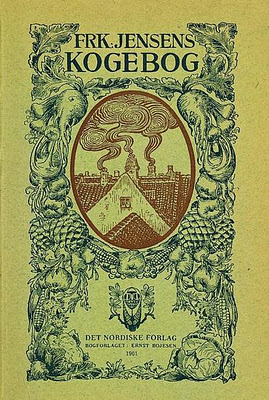 Frøken Jensens Kogebog cover
Frøken Jensens Kogebog cover
We also had a book (or perhaps several) by Camilla Plum, a contemporary homecook, who my mom consulted about “advanced” cooking such as Christmas cakes and duck roasting etc. Plum also advises Danish homecooks on “foreign” dishes and “exotic stews” aka daal and curry, which my mom always had an interest in.
Other than Christmas meals, my mom rarely cooked traditional Danish food. She grew up on a farm in rural Jylland, harvested grains with a tractor, took care of chickens, cows, etc., and wore wooden clogs exclusively until her midteens. She ate boiled potatoes and carrots every day with some sort of pan-fried pork, drank fresh milk, and had rolled oats with sugar for breakfast. Salt and pepper were the only spices. When she moved away from home age 16, she started cooking “Indian” food, perhaps as a rebellion against the very traditional home.
On the contrary, my dad is quite savvy with Danish cuisine. When he first moved to Copenhagen, he spent about a decade working jobs in kitchens both as an amateur chef and also as a dishwasher, waiter, etc. He worked in Jensens Bøfhus and in various cantines and because the clientele was Danes, he picked up Danes’ food predilections. This is also the time when my dad became known as “Kikkoman” because he “seasoned” the “frikadeller” (meatballs) with soy sauce. If anyone at home cooks Danish food, it is my dad.
We had some interesting discussions about how the food industry and lobby has changed recipes over time. We noticed that a lot of the American breads (banana bread, pumpkin bread, yogurt bread, corn bread, etc.) use vegetable oil instead of butter. When did this shift happen? (the shift from butter to margarine/shortening that is). I think there are several reasons for this: vegetable oil is easier to store, it’s cheaper, and unlike butter, you don’t need to melt it before you stir it into your bread batter. Basically, it helps busy homecooks + women working full time at home and outside the house. I also think there’s some beef between the oil industry and the dairy industry, but I’m not sure what exactly this is. At least I know that in Denmark the pork industry heavily lobbied and won over the fishing industry, so over the last seventy years or so, Danes have come to consume pork as the main protein instead of herring and other local fish.
-
the golden chersonese and the way thither
In Garden of Blues, we are joined by Victorian women who explored and documented the tropical belt. They were often described as “frail”; they struggled with “insomnia” and “nervous health.” Doctors advised them to stay in bed or to lead an “open air life.” Their journeys of recovery followed the webs of colonial infrastructure.
The British Isabella Bird visited Perak in the 1880s. In her travel log, she reported on a botanical experimental site that eventually would “pioneer” rubber plantations.
In Honduras, Dorothy Popenoe accompanied her husband, Wilson Poponoe, to the Lancetilla Botanical Experimental Station on the northeastern coast of Honduras. Founded in 1925 by the United Fruit Company, this station became a laboratory for botanical and agricultural experimentation.
Dorothy had worked in the Kew Gardens and then joined the United Nations Herbarium. Wilson had worked for the United States Department of Agriculture and from a “world voyage” in 1912, he had explored the fruits of the Malay Peninsula and South China.
In letters written from the Chersonese, he described the various fruits that would make “great acquisitions to countries such as Hawaii and Porto Rico (sic)” and also suggested importing Malayan fruits to Florida and California.
Under Wilson, Lancetilla imported species from the Malay peninsula.
An amateur botanist and archaeologist, Dorothy eventually died from eating an unripe, and therefore fatally poisonous, Ackee fruit.
The history of this fruit is entangled with the colonial quest for crops to feed enslaved people on British plantations in the Caribbean. For instance, the Ackee fruit had been shipped from Westafrica to Jamaica as part of the British slave trade.
William Blighs search for breadfruit trees in Tahiti famously ended with a mutiny in 1789. His ship, the Bounty, never reached the Caribbean and Bligh took shelter in Timor in the Dutch East Indies, a sojourn that opened up the Indo-Malay’s flora to the British.
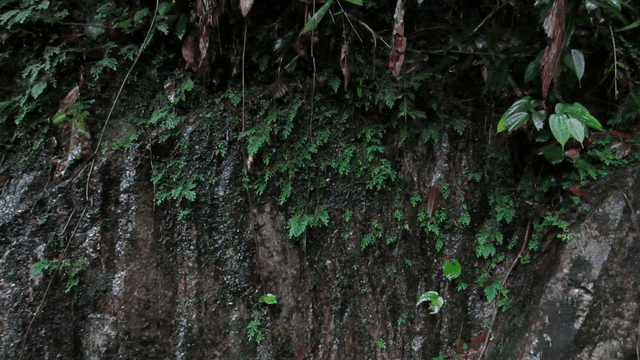
-
cash crops
Across the tropical belt, we find cash crops (agriculture for export) such as rubber, palm oil, coffee, tea, sugar cane, mais, and tobacco. They were disseminated at different times through various colonial networks for instance via the Spanish empire from the New World to the Philippines, via the British from the Malay archipelago to the Caribbean, and the Dutch and Portuguese trade posts from East Africa to the Indo-Malay world and to Macau. Early Arab trade routes parallel to the expansion of Islam were part of the early exchanges.
Today, Malaysia and Honduras import the same vegetables as the export. Their main partners are the US and China and surrounding countries such as Thailand and Guatemala.
El rambután
The name of the fruit “rambutan” stems from the Malay word for “hair” (cabello), a reference to the “hairy” shell. It originates from the lowlands of Indonesia. This fruit travelled via Arabic trade routes to East Africa during the expansion of Islam between the 10th and the 13th centuries. Much later, in the 19th century, the Dutch brought the rambutan from the Dutch East Indies to Suriname where it spread to the tropics of Central America. The Malay name for the fruit is used in Spanish and it is widely cultivated in Honduras and in Malaysia.
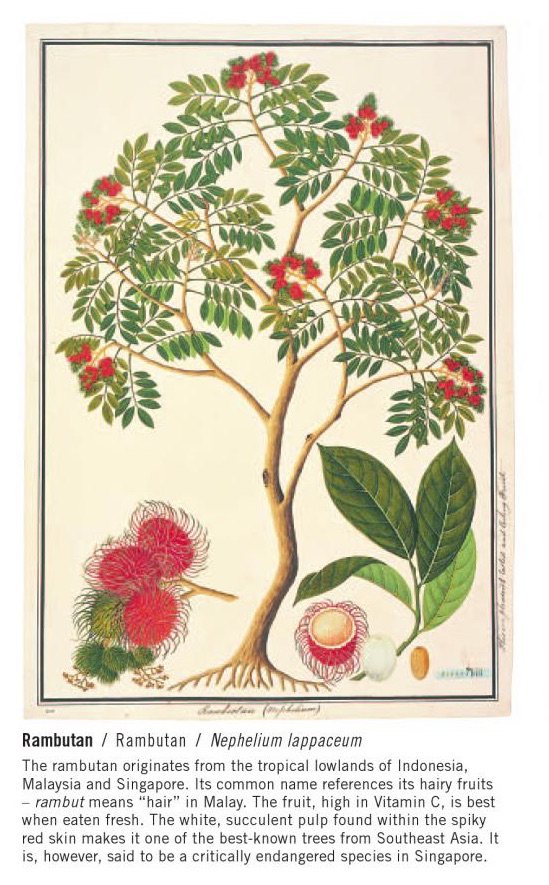
Bilimbi
Belimbing asam (mimbro in Spanish) is a sour fruit used for chutney, jams, and pickles; preserved dried or salted, and is eaten with rice and beans or curry. Native to the Malay world, it was carried from the island of Timor to Jamaica in 1793 from where it spread to Central America. Its journey may have overlapped with that of the breadfruit (see post on Victorian travellers).
Guava
Guava originates in Central America/Caribbean but can be found across the tropics today. It is eaten as a jam or fresh - with cumin and salt.
Ciku
The ciku fruit is native to Central America (el zapote in Spanish; sapodilla in English) and was introduced to the Philippines via the Spanish Empire. Today, it is widely cultivated in Malaysia and Mexico (mainly Yucatan).
Prickly Pear
Native to Central America, this cactus plant was cultivated in the gardens of British trade posts in Southeast Asia. It makes an appearance in William Farquhar’s collection of watercolors of Malayan flora and fauna from the early nineteenth century.
A Note on Names - Dutch Bananas and Custard Apples: The soursop-like “custard apple” is native to the New World but common in the Malay world. In Malaysia, figs are called pisang belanda (Dutch banana). Some colonial officers have even described the scent and flavor of durians as “very ripe strawberries.” Pisang raja and plantains (yellow, yellow, tasty fellow) “Indigenous to Southeast Asia” but often associated with cuisines of Central America, the Caribbean, and West Africa.
-
garden planning
Garden of Blues is a tribute to the many greens that have soothed us. It echoes the apple orchards of Grantchester, the rose and peony gardens of Cambridge University, the British hill stations in Perak, and Darwin’s greenhouse at Murray Edwards.
The visual design of our garden is modelled on “Islamic” ones. They come in many forms, one of which is the layout of four garden beds divided by two intersecting rivers. Garden of Blues is without a linear perspective, a mimicry of Mughal paintings. Islamic gardens of course also existed in, Europe perhaps most famously in Alhambra.
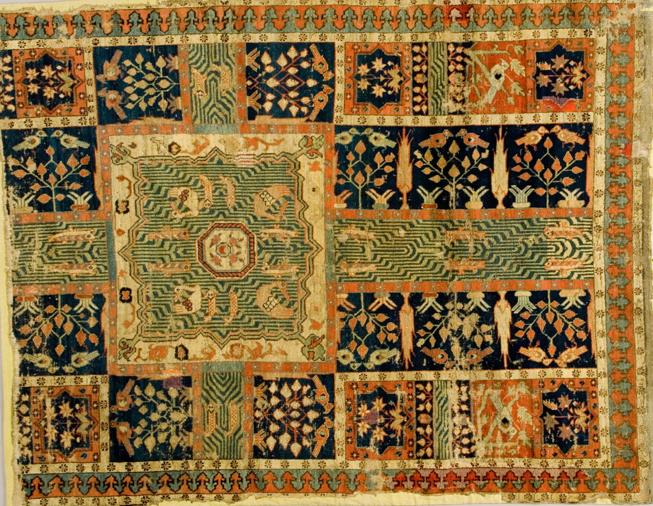
Given that Malaysia is often left out of the “traditional” Islamic (and Arab) world and that Honduras hosts a large community of Palestinians, we thought it’d be interesting to think about these two geographies through the genre of Islamic garden miniatures.
The flatness of the garden looks like a map. Perhaps the gridiron layout imitates the colonial town plannings of Tegucigalpa, Taiping, and Cambridge MA?
-
eurasian chefs
Semine realized a curious echo of her own biography in researching early records of recipes from the Malay world. She came across “Eurasian” women such as Beb Vuyk, author of “Groot Indonesisch Kookboek” (1973), and Ellice Handy, author of “My Favourite Recipes” (1952), who both documented overlaps between “local” and colonial/European cuisines.
Beb Vuyk’s recipes are in the process of being translated. You can follow the project on pisang.susu
cyanotype of pandan thai basil lime leaf and curry leaf !
-
a web of colonial nature
Colonial officers and naturalists shipped seeds and plant samples across empires as part of the searches for revenue potential and commercial exports. Botanists drew natural history illustrations that characterized a territory’s distinct “nature.”
The systematic division of empires into “biomes” rendered the colonized territory readable and governmental. Territories were classified as “climates” to facilitate transplantation of cash crops. This is how the “tropics” was born.
Tropical nature emerged from colonial fictions of pure, untouched land, a terra incognita with endless resources, a “wilderness” that begged colonial officers to push its edges and frontiers.
The tropics were at once a site of natural wealth that yielded resources and riches and a site of pestilences that degenerated health and morality; a postcard picturesque and paradisiacal environment as well as a dangerous landscape that needs to be controlled with pesticides and hygiene (racial, agricultural, etc.).
The plant specimens that were uprooted and seeded changed the ecologies of empires and what later became nation states.
Just like the tropics is populated with wildlife, so are computers: their codes and ports are full of bugs! In the early mechanical computers, it was actual insects that came in the way of the machine’s functioning.
We are cleaning up our code as we detect infestations.
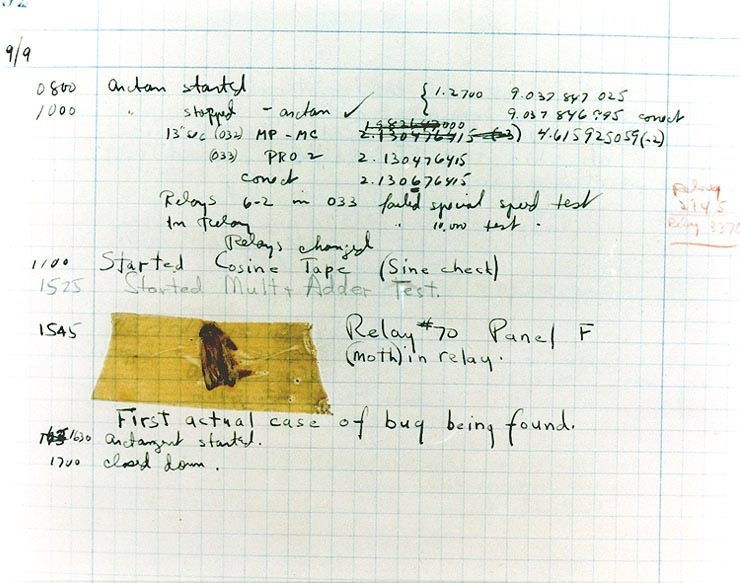
On a different note: Can a cyber-tropical garden push back at the idea of “vast jungles,” endless web scrolls, “Safari” searches, and InternetExploring?
-
a selfaware note on theory
moths in maxwell hills
Garden of Blues is a project born out of the 2018 MIT Architecture lingo. Donna Haraway’s sci-fi storytellings and her idea of “sowing worlds” appeared in almost all syllabi we encountered. Octavia Butler’s “Dawn” was the MIT Library selected book for Fall 2018. And words/phrases such as “kinship,” “non-human agents,” “inter-species communing,” “ecology,” “biome,” “imaginaries,” “contaminate,” “care,” and “speculative” were floating everywhere in the corridors of Building 4.
-
take root/eat root
A recurring discussion between Nancy and me: what is the difference between Honduran and Malaysian cuisine?
Is it the Malaysian use of fresh and dried herbs? Perhaps but how do we then explain that, in Honduras, mango and guava are eaten with cumin seeds?
Nancy thinks about different food textures: many of our Malaysian-inspired desserts are gooey and sticky and this “glue” texture rarely appears in Honduran foods.
Nancy also suggests that foods usually eaten savory in Honduras are served sweet in Malaysia and vice versa. For example, corn is used in tortilla, chips, grilled, etc. and eaten with cheese, beans, and chimol (a variation of pico de gallo). Corn in Malaysia is mostly used in desserts such as ice kacang. Another example is beans. In Honduras, they are refried as frijolitos with garlic and sometimes cheese (anafres). In Malaysia, beans are mostly used as a sweet filling in dumplings (fried or steamed) or in sweet bean soups with coconut and gula melaka. But then again what about the fermented black bean often used in stir-fry?
There are also curious overlaps. Take for instance sopa de caracol from the Caribbean coast (towns like Tela and La Ceiba serve this soup in eateries). Here, conch meat is simmered in coconut milk with coconut flesh, yucca, plantains, and spices like coriander, cinnamon, and cumin. This soup is strikingly similar to the Thai laksa with white fish, chilis, fat flat egg noodles, and fresh herbs in coconut milk.
Is the difference to be found in cooking techniques? Steaming (kuih, dumplings, fish, okra, etc.), fermenting (perut ikan, tapai, belacan), and pickling (acar awar) foods is very common in Malaysia and less so in Honduras. But there will always be exceptions such as the pickled curtido served with pupusas (granted that is supposedly a Salvadoran food).

-
recipe taxonomy
In contrast to encyclopaedias, compendiums, atlasses, etc., Garden of Blues will never be a complete or comprehensive overview of recipes. The recipes are deliberately organized around a vague archival taxonomy with little desire for order. Our recipes can appear in several gardens and some gardens are even empty.
The recipes are not divided into either “ Malaysian” or “Honduran” origins. The Honduran and Malaysian gardens contain no recipes. The icons simply rearrange themselves if you click on them: it is a fruitless dead-end to search for “national” cuisines (are we ourselves guilty of this very quest?)
The gardens refer not to geographies but to specific experiences, neighborhoods, and relationships.
In the words of Julian Tenison-Woods, a land-surveyor and Catholic priest who conducted land surveys in Malaya in 1884:
“perhaps in no country in the world is exploration rendered so difficult from the extraordinary thickness of the jungle and the steepness of the mountain ridges which increasingly cross the travellers path.”What we are venturing into is not the wilderness of a “borderland” of colonial imagination, but an emotional and sensory landscape of foods and friendship, which actually is pretty wild.
-
massachusetts markets
Garden of Blues sources its produce from Cambridge/Somerville MA.
Here’s a mini-ethnography of the supermarkets we frequent, mostly in the form of questions.
First, we thought about the role of an “international isle” in the grand design of supermarkets. Does it reveal anything about the neighborhoods’ migration patterns, or is it a testament to the level of “adventuredness” of the surrounding New Englanders?
How do you know what community a supermarket caters to? Especially given the fact that the same vegetables are grown across the tropics.
Are shiny stores only for the “wealthy international student figure”?
We noticed that in Somerville’s Market Basket Natura’s refried beans share shelf space with Thai shrimp pastes in the “ethnic aisle.” The vegetable section has mouldy yams, tapiocas/cassavas/yuccas, and plantains/pisang. Tostones crisps are next to knækbrød and keropok.
Did the British succeed in evening out differences between regions? Did the tropics become a homogenous belt of large-scale industrial agriculture where any crop grown Honduras also can be found in Malaysia? Can any food eaten in Malaysia also become part of Honduran cuisine?
HMart is almost exclusively focused on East Asia. Where does Southeast Asia fit into the selection of “Asian” groceries? Is this region - a US Cold War invention - a Hinterindien that does not quite make it into the category of “real” Asia?
We noticed that most of the workers in the HMart on Mass Ave are Mexican. This adds another “regional layer” to our grocery trip: the dynamics of Central America. Hondurans and El Salvadoreans make up the largest proportion of immigrant workers and indentured laborers. How does Nancy fit into this social dance?
-
hello semine
You’ll find this post in your
_postsdirectory. Go ahead and edit it and re-build the site to see your changes. You can rebuild the site in many different ways, but the most common way is to runjekyll serve, which launches a web server and auto-regenerates your site when a file is updated.Jekyll requires blog post files to be named according to the following format:
YEAR-MONTH-DAY-title.MARKUPThis is a margin note.
Where
YEARis a four-digit number,MONTHandDAYare both two-digit numbers, andMARKUPis the file extension representing the format used in the file. After that, include the necessary front matter. Take a look at the source for this post to get an idea about how it works.This is a blockquote
Where
YEARis a four-digit number,MONTHandDAYare both two-digit numbers, andMARKUPis the file extension representing the format used in the file. After that, include the necessary front matter. Take a look at the source for this post to get an idea about how it works.Jekyll also offers powerful support for code snippets:
def print_hi(name) puts "Hi, #{name}" end print_hi('Tom') #=> prints 'Hi, Tom' to STDOUT. this is a margin image
this is a margin image
Check out the Jekyll docs for more info on how to get the most out of Jekyll. File all bugs/feature requests at Jekyll’s GitHub repo. If you have questions, you can ask them on Jekyll Talk.
 This is a full width image
This is a full width image